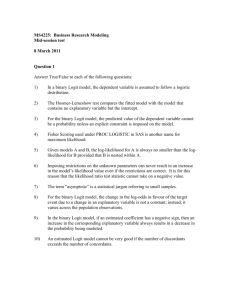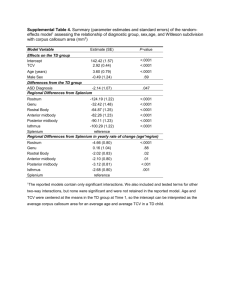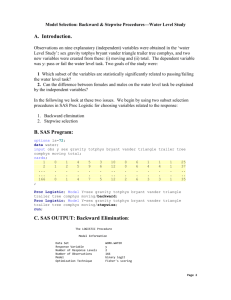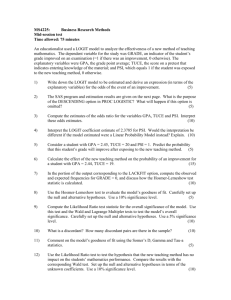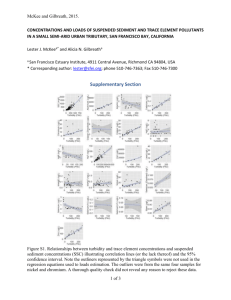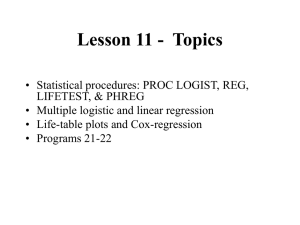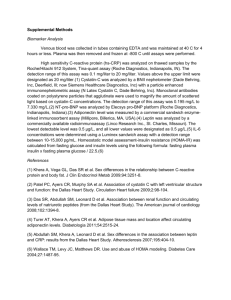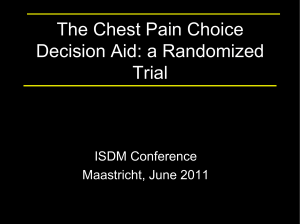Test 2013
advertisement
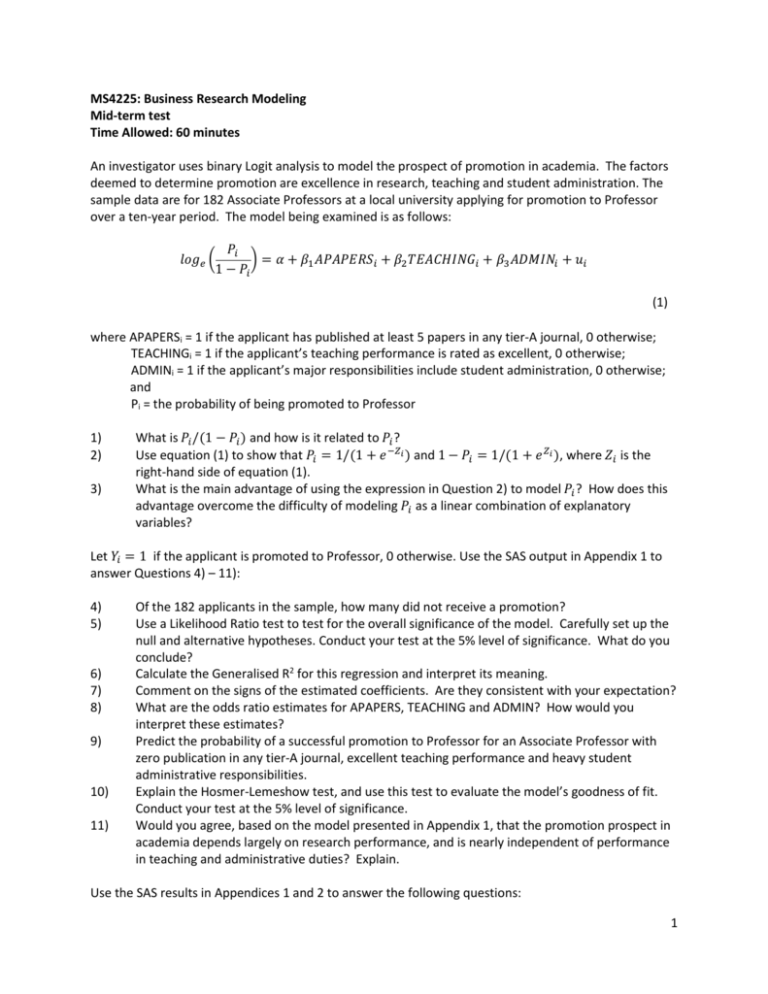
MS4225: Business Research Modeling Mid-term test Time Allowed: 60 minutes An investigator uses binary Logit analysis to model the prospect of promotion in academia. The factors deemed to determine promotion are excellence in research, teaching and student administration. The sample data are for 182 Associate Professors at a local university applying for promotion to Professor over a ten-year period. The model being examined is as follows: 𝑃𝑖 𝑙𝑜𝑔𝑒 ( ) = 𝛼 + 𝛽1 𝐴𝑃𝐴𝑃𝐸𝑅𝑆𝑖 + 𝛽2 𝑇𝐸𝐴𝐶𝐻𝐼𝑁𝐺𝑖 + 𝛽3 𝐴𝐷𝑀𝐼𝑁𝑖 + 𝑢𝑖 1 − 𝑃𝑖 (1) where APAPERSi = 1 if the applicant has published at least 5 papers in any tier-A journal, 0 otherwise; TEACHINGi = 1 if the applicant’s teaching performance is rated as excellent, 0 otherwise; ADMINi = 1 if the applicant’s major responsibilities include student administration, 0 otherwise; and Pi = the probability of being promoted to Professor 1) 2) 3) What is 𝑃𝑖 /(1 − 𝑃𝑖 ) and how is it related to 𝑃𝑖 ? Use equation (1) to show that 𝑃𝑖 = 1/(1 + 𝑒 −𝑍𝑖 ) and 1 − 𝑃𝑖 = 1/(1 + 𝑒 𝑍𝑖 ), where 𝑍𝑖 is the right-hand side of equation (1). What is the main advantage of using the expression in Question 2) to model 𝑃𝑖 ? How does this advantage overcome the difficulty of modeling 𝑃𝑖 as a linear combination of explanatory variables? Let 𝑌𝑖 = 1 if the applicant is promoted to Professor, 0 otherwise. Use the SAS output in Appendix 1 to answer Questions 4) – 11): 4) 5) 6) 7) 8) 9) 10) 11) Of the 182 applicants in the sample, how many did not receive a promotion? Use a Likelihood Ratio test to test for the overall significance of the model. Carefully set up the null and alternative hypotheses. Conduct your test at the 5% level of significance. What do you conclude? Calculate the Generalised R2 for this regression and interpret its meaning. Comment on the signs of the estimated coefficients. Are they consistent with your expectation? What are the odds ratio estimates for APAPERS, TEACHING and ADMIN? How would you interpret these estimates? Predict the probability of a successful promotion to Professor for an Associate Professor with zero publication in any tier-A journal, excellent teaching performance and heavy student administrative responsibilities. Explain the Hosmer-Lemeshow test, and use this test to evaluate the model’s goodness of fit. Conduct your test at the 5% level of significance. Would you agree, based on the model presented in Appendix 1, that the promotion prospect in academia depends largely on research performance, and is nearly independent of performance in teaching and administrative duties? Explain. Use the SAS results in Appendices 1 and 2 to answer the following questions: 1 12) 13) Use a Likelihood Ratio test to test for the joint significance of TEACHING and ADMIN on the probability of receiving a promotion. Conduct your test at the 5% level of significance. In your view, which of the two models in Appendices 1 and 2 is a superior model? Carefully explain your answer. Appendix 1 The LOGISTIC Procedure Model Information Data Set Response Variable Number of Response Levels Number of Observations Model Optimization Technique WORK.TEST Y 2 182 binary logit Fisher's scoring Response Profile Ordered Value Y Total Frequency 1 2 1 0 83 99 Probability modeled is Y=1. Model Convergence Status Convergence criterion (GCONV=1E-8) satisfied. Model Fit Statistics Criterion AIC SC -2 Log L Intercept Only Intercept and Covariates 252.897 256.101 250.897 85.771 98.587 77.771 Testing Global Null Hypothesis: BETA=0 Test Chi-Square DF Pr > ChiSq ???????? 141.5000 64.5709 3 3 3 <.0001 <.0001 <.0001 Likelihood Ratio Score Wald The LOGISTIC Procedure Analysis of Maximum Likelihood Estimates Parameter DF Estimate Standard Error Wald Chi-Square Pr > ChiSq Intercept 1 -4.0731 0.8579 22.5432 <.0001 2 APAPERS TEACHING ADMIN 1 1 1 6.0149 1.0274 -0.1344 0.7771 0.7041 0.6347 59.9046 2.1291 0.0448 <.0001 0.1445 0.8323 Odds Ratio Estimates Effect Point Estimate APAPERS TEACHING ADMIN 95% Wald Confidence Limits ???? ???? ???? 89.274 0.703 0.252 >999.999 11.107 3.033 Association of Predicted Probabilities and Observed Responses Percent Concordant Percent Discordant Percent Tied Pairs 94.1 3.1 2.8 8217 Somers' D Gamma Tau-a c 0.910 0.937 0.454 0.955 Partition for the Hosmer and Lemeshow Test Group Total Observed Event Expected 1 2 3 4 5 6 7 8 20 18 25 31 21 21 24 22 0 0 2 1 18 19 22 21 0.29 0.30 1.00 1.41 18.04 18.37 22.67 20.93 Nonevent Observed Expected 20 18 23 30 3 2 2 1 19.71 17.70 24.00 29.59 2.96 2.63 1.33 1.07 Hosmer and Lemeshow Goodness-of-Fit Test Chi-Square DF Pr > ChiSq 2.3117 6 0.8889 Appendix 2 The LOGISTIC Procedure Model Information Data Set Response Variable Number of Response Levels Number of Observations Model Optimization Technique WORK.TEST Y 2 182 binary logit Fisher's scoring Response Profile Ordered Value Y Total Frequency 3 1 2 1 0 83 99 Probability modeled is Y=1. Model Convergence Status Convergence criterion (GCONV=1E-8) satisfied. Model Fit Statistics Criterion AIC SC -2 Log L Intercept Only Intercept and Covariates 252.897 256.101 250.897 84.187 90.595 80.187 Testing Global Null Hypothesis: BETA=0 Test Chi-Square DF Pr > ChiSq 170.7099 140.9750 67.7842 1 1 1 <.0001 <.0001 <.0001 Likelihood Ratio Score Wald The LOGISTIC Procedure Analysis of Maximum Likelihood Estimates Parameter DF Estimate Standard Error Wald Chi-Square Pr > ChiSq Intercept APAPERS 1 1 -3.4122 5.7148 0.5868 0.6941 33.8162 67.7842 <.0001 <.0001 Odds Ratio Estimates Effect Point Estimate APAPERS 303.315 95% Wald Confidence Limits 77.814 >999.999 Association of Predicted Probabilities and Observed Responses Percent Concordant Percent Discordant Percent Tied Pairs 88.6 0.3 11.1 8217 Somers' D Gamma Tau-a c 0.883 0.993 0.441 0.942 4
